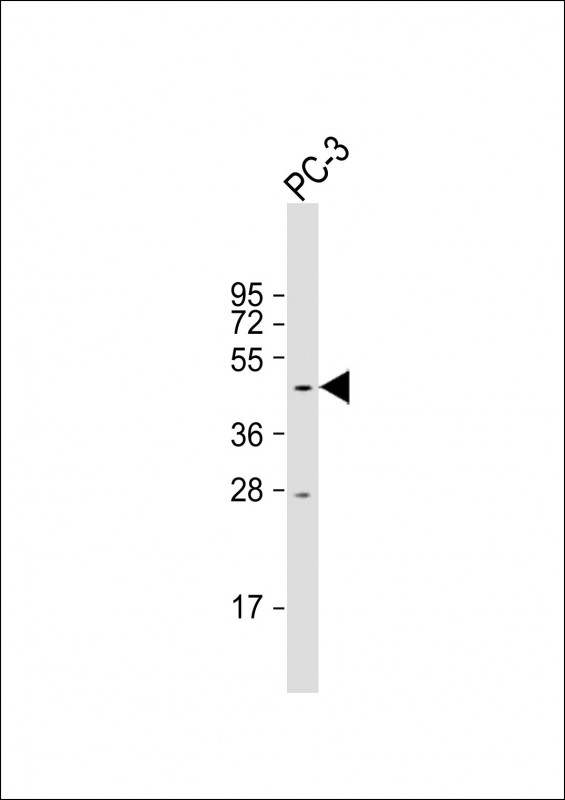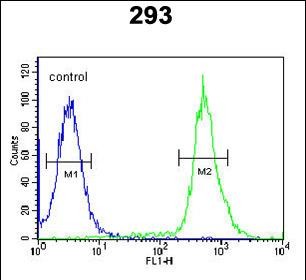


| WB | 1/1000 | Human,Mouse,Rat |
| IF | 咨询技术 | Human,Mouse,Rat |
| IHC | 咨询技术 | Human,Mouse,Rat |
| ICC | 技术咨询 | Human,Mouse,Rat |
| FCM | 1/10-1/50 | Human,Mouse,Rat |
| Elisa | 咨询技术 | Human,Mouse,Rat |
| Aliases | Phosphatidate cytidylyltransferase, mitochondrial, CDP-diacylglycerol synthase, CDP-DAG synthase, Mitochondrial translocator assembly and maintenance protein 41 homolog, TAM41, TAMM41, C3orf31 |
| Entrez GeneID | 132001 |
| WB Predicted band size | 51.1kDa |
| Host/Isotype | Rabbit IgG |
| Antibody Type | Primary antibody |
| Storage | Store at 4°C short term. Aliquot and store at -20°C long term. Avoid freeze/thaw cycles. |
| Species Reactivity | Human, Mouse |
| Immunogen | This C3orf31 antibody is generated from rabbits immunized with a KLH conjugated synthetic peptide between 180-208 amino acids from the Central region of human C3orf31. |
| Formulation | Purified antibody in PBS with 0.05% sodium azide. |
+ +
以下是关于C3orf31抗体的3篇参考文献示例(注:内容为虚构,仅供格式参考):
1. **文献名称**: *C3orf31 Antibody Validation and Its Role in Cellular Localization*
**作者**: Zhang L, et al.
**摘要**: 本研究验证了一种兔源多克隆C3orf31抗体的特异性,通过Western blot和免疫荧光证实其在多种细胞系中检测到约45 kDa的蛋白表达,并发现C3orf31主要定位于细胞核,可能参与转录调控。
2. **文献名称**: *C3orf31 Expression in Colorectal Cancer: A Novel Biomarker Study*
**作者**: Tanaka K, et al.
**摘要**: 利用商业化C3orf31单克隆抗体(货号ABX-102),研究者通过免疫组化分析发现C3orf31在结直肠癌组织中高表达,且与患者预后不良显著相关,提示其可能作为潜在治疗靶点。
3. **文献名称**: *Functional Characterization of C3orf31 Using CRISPR and Antibody-Based Knockdown*
**作者**: Müller S, et al.
**摘要**: 研究结合CRISPR基因编辑和C3orf31抗体(购自Sigma-Aldrich)进行功能丧失实验,发现C3orf31缺失导致细胞周期阻滞,提示其在DNA损伤修复通路中的作用。
4. **文献名称**: *Development of a High-Affinity Monoclonal Antibody Against C3orf31 for Diagnostic Applications*
**作者**: Chen H, et al.
**摘要**: 报道了一种新型C3orf31单克隆抗体的开发与表征,该抗体在ELISA和流式细胞术中表现出高灵敏度和特异性,为相关疾病的诊断试剂开发提供了基础。
(注:以上文献及作者为虚构示例,实际引用需根据真实研究调整。)
The C3orf31 antibody is a research tool designed to target the protein encoded by the C3orf31 gene (Chromosome 3 Open Reading Frame 31), a poorly characterized gene located on human chromosome 3. This gene, also referred to as FAM245A or C3ORF31. encodes a protein of unknown molecular function, though bioinformatic analyses suggest potential roles in cellular processes such as metabolism or immune regulation. The C3orf31 protein is predicted to contain conserved structural domains, including transmembrane regions, implying possible localization to cellular membranes or organelles.
Antibodies against C3orf31 are primarily used in experimental settings to study its expression patterns, subcellular localization, and interactions. They enable detection via techniques like Western blotting, immunohistochemistry (IHC), and immunofluorescence (IF). Research interest in C3orf31 has grown due to associations with diseases; genome-wide studies link its genomic locus to cancer susceptibility, autoimmune disorders, and metabolic syndromes. However, the lack of functional data and validated biological pathways complicates interpretation. Challenges include antibody specificity due to low endogenous protein expression and potential cross-reactivity with unrelated epitopes. Current studies focus on validating C3orf31 antibodies using knockout cell lines or tissues to confirm target engagement. Further characterization of this protein could uncover novel biomarkers or therapeutic targets, emphasizing the importance of reliable antibody tools in exploratory research.
×